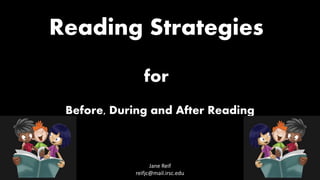
Reading Strategies for Non-Fiction
- 1. Reading Strategies for Before, During and After Reading Jane Reif reifjc@mail.irsc.edu
- 2. Reading Comprehension The active process of obtaining meaning from written text
- 3. Before Reading •Preview •Set a Purpose •Predict •Question •Activate Prior Knowledge These strategies will prepare you for what you are about to read
- 4. PREVIEW • Read headlines and subtitles • Read captions and side bars • Look at pictures and other graphics You will get some information about what you will be reading
- 5. SET A PURPOSE • Why are you reading this? • Is it to learn about a something? • Is it to learn how to do something? • Is it to get information on a subject, place or person?
- 6. PREDICT About information that you expect to find Write down what you think will happen next
- 7. QUESTIONS Write down questions that you want answered What information do you do you want from the text? Write the questions in the margin or on sticky notes
- 8. ACTIVATE PRIOR KNOWLEDGE Think about what you already know about the subject • Text to self- are there connections between the text and your personal experiences? • Text to world-are there connections between text and facts and information about the world? • Text to text-is there a connection between the text and something else you have read? This will help understand the meaning of what you are reading
- 10. VISUALIZE Use pictures to help you create mental pictures Use your own experiences to add images This will create a “Mental Movie” to help you better understand what you are reading
- 11. RE-READ If you have read a sentence that doesn’t make sense to you RE-READ IT If you do not understand what a paragraph is telling you RE-READ IT Is there a word that doesn’t sound right in the sentence? RE-READ IT If you stop and re-read you will not continue reading with the wrong information
- 12. QUESTIONS Create questions that you want answered while reading What more would you like to know? Think about what the author is not telling you
- 13. VOCABULARY When you come across a word that you don’t know the meaning of use context clues. Read the sentence again and look at the words around it. This may help you understand the meaning Look at text structure of the word. See if there is a familiar prefix,root or suffix If the word is in bold print or has a footnote indication(small number next to it), look for the definition on the page Use the glossary If necessary, get a dictionary and look it up. Vocabulary knowledge is important to understand what you are reading
- 14. INFER As you read, make predictions about what the text will tell you. Use clues from the author and your knowledge to draw conclusions Revise these as you read more
- 16. REFLECT Think about what the text was mainly about Talk about it Write about it Draw it
- 17. RE-READ Re-read for clarification If something was unclear or confusing, re-read it
- 18. SUMMARIZE Read the first sentence of each paragraph Write down the most important points Talk about the most important points
- 19. REVIEW Look back Were your questions answered? Did you get the important information?
- 20. Question Ask yourself if you have any questions that are still unanswered. Was there more that you wanted to know? Were your questions before reading answered?
- 21. R E M E M B E R Reading is Thinking
- 22. REFERENCES • Study Skills Activities:Reading as a Study Skill. Montana State Literacy Resources: A Service of the National Institute of Literacy. • http://www.nwlincs.org/mtlincs/pilotproject/studyskillsindex.htm • Beers, K. (1998). When Kids Can't Read. • Bursuck, W. D., & Damer, M. (2011). Teaching Reading to Students Who Are at Risk or Have Disabilities. Upper Saddle River: Pearson. • Keene, E. O. (2002). Comprehension Strategies.